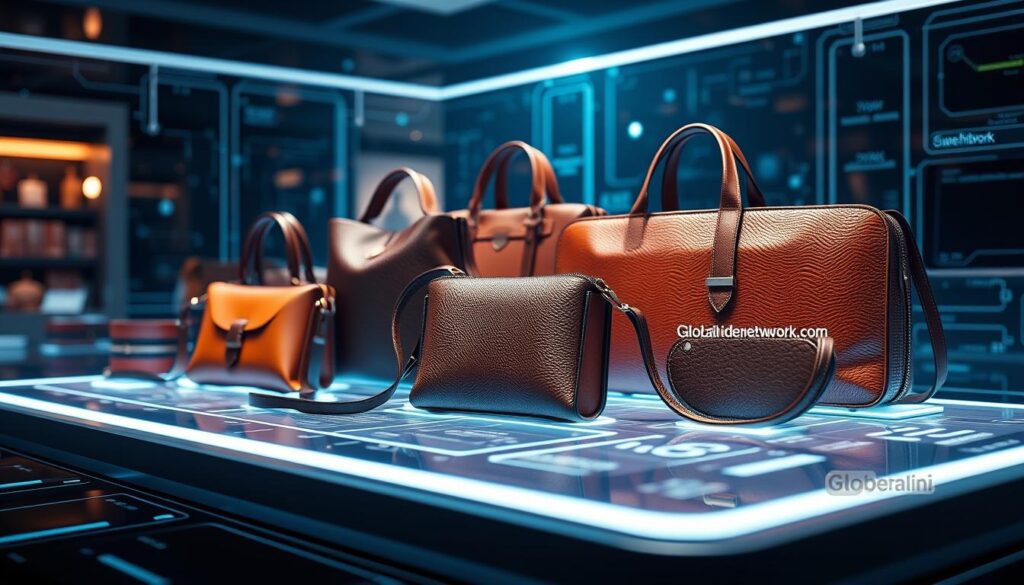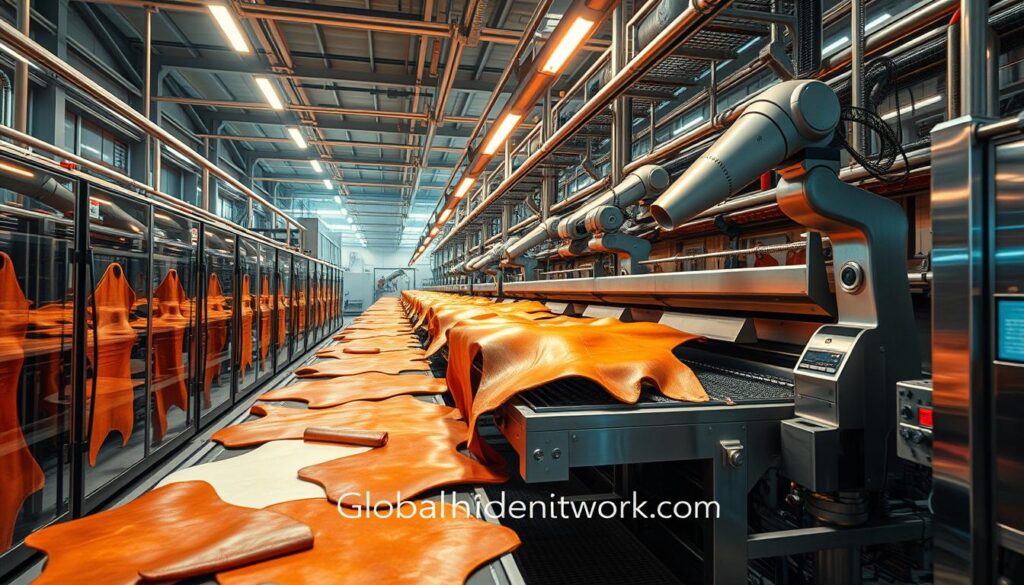I’ve seen a big change in leather trading. Old ways don’t work anymore. Digital platforms and e-commerce are now key.
Businesses stuck in the past face challenges. But there’s hope. By using technology, leather traders can reach global markets and make their supply chain better.
Key Takeaways
- Digital platforms are reshaping leather trading
- E-commerce expands market reach for leather businesses
- Technology improves supply chain management efficiency
- Global market access is now possible through digital tools
- Adapting to tech changes is crucial for leather industry survival
The Evolution of Leather Trading in the Digital Age
Leather trading has changed a lot in recent years. It moved from old ways to digital platforms. This big change brings new chances and challenges for all.
From Traditional Methods to Digital Platforms
Now, leather trading doesn’t just happen face-to-face anymore. Digital platforms have changed everything. They let buyers and sellers meet instantly, no matter where they are.
This change is amazing. It makes things faster that used to take weeks or months.
The Rise of E-commerce in Leather Trading
E-commerce has changed leather trading a lot. Online stores offer many leather products easily. This has made things more competitive and given customers more choices.
The global leather goods market is growing fast. It’s going up about 7% every year, thanks to online shopping.
Global Market Accessibility Through Technology
Technology has made leather trading global. Now, even small businesses can sell to people all over the world. This makes the market more diverse and competitive.
The leather industry is still changing. Those who use digital platforms and e-commerce will do well in this new world.
The Role of Technology in Leather Trading
Technology is changing the leather trade in big ways. It’s key for staying ahead and meeting new customer needs. New ideas are making a big impact, from making leather to selling it.
The leather world is moving towards being more green. By 2015, top tanneries were recycling more and using less energy and water. This shows a big step towards being more eco-friendly.
Online platforms are making deals easier, and smart making processes are making things more efficient. Using IoT, tanneries can keep an eye on things like color and water resistance. This helps keep quality high and meets rules.
| Aspect | Impact of Technology |
|---|---|
| Sustainability | Zero solid waste, water recycling |
| Production | Smart manufacturing, IoT monitoring |
| Quality Control | AI-driven systems |
| Trading | Blockchain-based systems |
Blockchain is making it easier to track where leather comes from. This is key for dealing with environmental issues and following rules. Using technology is not just a choice; it’s a must for tanneries to succeed today.
Digital Platforms Transforming Leather Transactions
I’ve seen a big change in leather trading thanks to digital platforms. These new tools are changing how we buy, sell, and use leather products. Let’s explore the exciting changes in our industry.
Online Marketplaces for Leather Products
Online marketplaces have changed the game for leather traders. They’ve made it easier to find products from all over the world. This has cut down costs and made the supply chain more open.
Virtual Showrooms and 3D Product Visualization
Virtual showrooms are taking leather shopping to a new level. With 3D product visualization, you can see products up close from anywhere. This tech mixes the best of online and in-person shopping, making it better for customers.

Blockchain-based Trading Systems
Blockchain traceability is solving big problems in leather trading. It makes the supply chain more transparent and accountable. This tech helps ensure products are made ethically and sustainably, which matters to buyers.
| Digital Platform | Benefits | Impact on Leather Trading |
|---|---|---|
| Online Marketplaces | Global access, reduced costs | Expanded customer base, efficient transactions |
| Virtual Showrooms | Detailed product inspection | Enhanced customer experience, increased sales |
| Blockchain Systems | Improved traceability | Increased trust, ethical sourcing assurance |
These digital platforms are not just changing leather trading. They’re changing the whole industry. By using these technologies, we’re making the leather market more efficient, open, and focused on customers.
Supply Chain Management in the Tech Era
Technology has changed how we manage supply chains in the leather industry. New systems help us track inventory and improve logistics.
ERP systems give us real-time info on stock levels. This helps us make better choices and avoid stock problems.
RFID tracking is a big help. It lets us follow leather products from start to finish. This makes it easier to:
- Prevent loss and theft
- Check if products are real
- Manage inventory better
Now, we focus more on making logistics better. Data and AI help us plan smarter routes. This saves money and helps the planet.
| Supply Chain Aspect | Technology Impact |
|---|---|
| Inventory Management | 84% increase in efficiency with ERP systems |
| Product Tracking | 98% accuracy with RFID technology |
| Logistics Optimization | 15% reduction in transportation costs |
With these new tech tools, the leather industry is getting more efficient and open.
Tannery Automation: Enhancing Efficiency and Quality
Tannery automation is changing the leather industry. It’s making production lines more efficient and improving quality. New technologies like Industry 4.0 are making it possible to control and monitor production more precisely.
Smart Manufacturing Processes
Smart manufacturing uses advanced tech to make tanneries better. These systems adjust production settings in real-time. For example, automated drum systems control temperature and chemicals, making leather quality better.
IoT-enabled Production Monitoring
IoT devices are now used in tanneries. They collect data on production and environment. This helps make quick changes and prevent problems, cutting downtime and boosting efficiency.
AI-driven Quality Control Systems
AI quality control is changing leather making. Machine vision systems spot defects and quality issues with high accuracy. This makes products consistent and cuts down on human mistakes.

| Technology | Benefits | Impact on Efficiency |
|---|---|---|
| Smart Manufacturing | Precise control of production parameters | 25-50% productivity increase |
| IoT Monitoring | Real-time data on machine performance | 15-30% waste reduction |
| AI Quality Control | Consistent product quality | 95-100% quality consistency |
Tannery automation is changing the leather industry. It’s making production more efficient and improving quality. With smart manufacturing, IoT, and AI, tanneries can reduce waste and make work safer. As these technologies improve, we’ll see even better results in leather production.
Sustainable Leather Production Through Technology
Technology has changed sustainable leather production a lot. Lab-grown leather is now a big deal. Lab-Grown Leather Ltd (LGL) makes a real animal tissue product without hurting animals. This green option helps solve problems like pollution, deforestation, and animal cruelty in old leather-making ways.
The leather industry is also getting better thanks to the circular economy. The Scottish Leather Group’s 2023 ESG report shows great progress:
- 90% less carbon pollution in 20 years
- All raw materials are traced
- 77% of waste was recycled in 2022
These numbers show how tech can make things better. The Super Tannery at Bridge of Weir Leather cut energy use by 82% and water use by 42% compared to before.
More people want eco-friendly options. Vegan leather belts from plants are a kind choice. Using recycled materials in belts also cuts down waste and harm to the planet. The leather world is moving towards smart, green choices because of what people want.
| Sustainability Measure | Achievement |
|---|---|
| Carbon Intensity Reduction | 90% over 20 years |
| Raw Material Traceability | 100% |
| Waste Recycling | 77% in 2022 |
| Energy Consumption Reduction | 82% at Super Tannery |
| Water Usage Reduction | 42% at Super Tannery |
Data Analytics: Driving Informed Decision-Making
Data analytics has changed the leather industry a lot. It’s not just about numbers. It’s about making smart choices that help us grow.
Predictive Analytics for Market Trends
Predictive analytics lets us see what’s coming in the market. We don’t just guess anymore. By analyzing data, we spot trends early.
Customer Behavior Insights
Knowing our customers is crucial. Data analytics gives us a clear view of what they want. This helps us make products they’ll love and market them well.
Inventory Optimization Strategies
We don’t have to worry about too much stock or running out of items anymore. Data-driven inventory optimization keeps our stock just right. This saves money and keeps customers happy.
| Data Analytics Application | Benefits in Leather Trading |
|---|---|
| Predictive Analytics | Forecasts market trends, reduces risks |
| Customer Behavior Analysis | Improves product development, enhances marketing |
| Inventory Optimization | Reduces costs, increases efficiency |
Data analytics has a big impact. It’s not just for big tech companies. In the leather industry, we use these tools to make better choices every day. From predicting trends to keeping inventory lean, data is our secret to success.
Challenges and Opportunities in Tech-Driven Leather Trading
The leather industry is at a turning point. It faces big challenges, but there’s hope. New opportunities are emerging, thanks to technology.
Environmental worries and following rules are major issues. Yet, these problems are driving innovation. Companies that use tech and care for the planet are doing well.
Let’s look at some numbers:
| Metric | Value | Period |
|---|---|---|
| Leather Goods Repair Services CAGR | 13.57% | 2023-2031 |
| Market Value (2024) | $9.64 Billion | Current |
| Projected Market Value (2031) | $20.69 Billion | Future |
These numbers show a promising future for leather. Repair services are growing fast, thanks to tech and customer needs. This growth offers great chances for businesses ready to change.
Digital tools are key for all tanneries now. It’s not just to keep up; it’s to lead. Companies working with tech experts are ready to face challenges and find new chances.
The leather industry is changing. With the right use of technology, challenges can lead to success.
Conclusion: Embracing the Future of Leather Trading
The leather industry has changed a lot. Now, it’s all about using technology and being green. Companies are using solar and wind power to save money and help the planet.
They’re also using less water and chemicals. This is good news for our environment.
Factories are getting smarter. They’re using robots and computers to make better leather with less waste. This is important because more people want eco-friendly products.
Some brands are even trying out new materials like mushroom leather or lab-grown options.
The way we buy and sell leather is changing too. Online markets and virtual showrooms are making it easier to trade globally. Plus, new rules like the European Union Deforestation Regulation are pushing for more transparency in where leather comes from.
To stay ahead, companies need to embrace technological innovation and sustainable practices. They must track their leather from start to finish and work closely with suppliers. It’s a big change, but it’s exciting. The future of leather trading looks bright for those who adapt and put the planet first.
